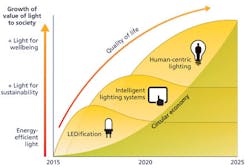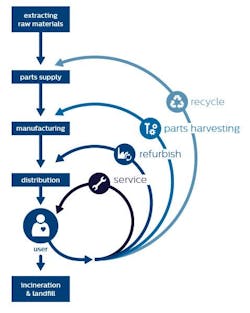European organization explores how the circular economy movement could add to the growth opportunity in the SSL sector and how policy can encourage such a possibility.
LightingEurope has published a whitepaper entitled “Serviceable luminaires in a circular economy” that explores how the lighting sector can contribute to and benefit from the so-called circular economy movement. Many LED-based lighting products today are not serviceable, although the potential to add some level of support for repair is certainly possible. And LightingEurope believes that the solid-state lighting (SSL) sector could benefit beyond the LED transition (sometimes called LEDification) currently underway, with the circular economy delivering added profits.
Interested in articles & announcements on policy and standards for the LED and lighting industry?
“We clearly see that the lighting industry, boosted by the fast transition towards LEDification, is moving in the direction of manufacturing circular products with extended lifetimes and additional capabilities compared to conventional products,” said Ourania Georgoutsakou, LightingEurope secretary general. Georgoutsakou stepped into the leadership position at LightingEurope earlier this year. LightingEurope is an organization that represents European lighting manufacturers, national lighting associations, and other parties in lobbying for policy matters that benefit the industry and in setting industry-wide, forward-looking market and technology roadmaps. For example, the organization has pushed the European lighting industry to accelerate the proliferation of human-centric lighting (HCL).
LightingEurope previously developed a roadmap for human-centric lighting in the hopes of increasing the technology uptake alongside appropriate policy measures that could advance the lighting industry. (Image credit: LightingEurope.)
The new whitepaper examines potential growth opportunities and new business models that might benefit the lighting sector based on a transition to luminaires that can be repaired and upgraded. At the same time, the document points out potential issues in terms of safety and quality that must be mitigated in any movement to a broader industry focused on serviceability. LightingEurope has long touted the circular economy as a foundation above which opportunities in smart lighting or the Internet of Things (IoT), and later HCL could be realized (see graph above).
The circular economy, as the nearby illustration defines, is based on concentric loops focused on servicing and refurbishing products, harvesting components in products that can be repaired, and ultimately recycling other materials in a way that those materials can re-enter the economy. The inner servicing and refurbishing loops would office the highest market value.
In its new whitepaper, LightingEurope establishes the concept that serviceable luminaires have a place in a circular economy model for the lighting industry, building new business for manufacturers and service providers. (Image credit: Philips Lighting via LightingEurope.)
The whitepaper defines many potential benefits of supporting the circular model, starting with longer lifetime and less waste. Upgradeability would enable further energy-efficiency gains down the road, as well as the ability to add new features such as connectivity.
Other benefits may be a bit more surprising. LightingEurope said the model would connect manufacturers more closely to their customers, potentially enabling the manufacturers to support evolving customer needs with new products or services. Moreover, serviceable luminaires would create new jobs to handle maintenance, monitoring, and even data analytics.
The whitepaper explores the concept of serviceability or upgrade relative to LED modules (or light engines), control gear (drivers), lamps, and sensor/network transceivers (IoT support, for instance). LightingEurope will encourage its member companies to consider the circular model in the product development stage. And the organization will lobby the European Commission to establish policy that rewards participation in the circular movement.
You can read the entire whitepaper on the LightingEurope website.







